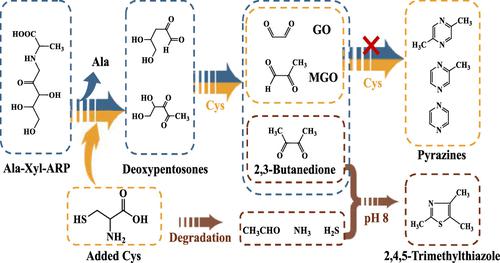当前位置:
X-MOL 学术
›
J. Agric. Food Chem.
›
论文详情
Our official English website, www.x-mol.net, welcomes your feedback! (Note: you will need to create a separate account there.)
Competitive Formation of 2,3-Butanedione and Pyrazines through Intervention of Added Cysteine during Thermal Processing of Alanine-Xylose Amadori Compounds
Journal of Agricultural and Food Chemistry ( IF 6.1 ) Pub Date : 2022-11-29 , DOI: 10.1021/acs.jafc.2c07026 Tong Zhou 1 , Xue Xia 1 , Heping Cui 1 , Khizar Hayat 2 , Xiaoming Zhang 1 , Chi-Tang Ho 3
Journal of Agricultural and Food Chemistry ( IF 6.1 ) Pub Date : 2022-11-29 , DOI: 10.1021/acs.jafc.2c07026 Tong Zhou 1 , Xue Xia 1 , Heping Cui 1 , Khizar Hayat 2 , Xiaoming Zhang 1 , Chi-Tang Ho 3
Affiliation

|
The intervention of cysteine (Cys) on the formation of 2,3-butanedione and pyrazines was evaluated during the thermal processing of the alanine-xylose Amadori compound (AX-ARP). With the involvement of Cys, the competitive formation of 2,3-butanedione and pyrazines was induced. The formation of 2,3-butanedione in the AX-ARP/Cys model was suppressed due to the inhibitory effect of the precursors of 2,3-butanedione like deoxypentosones, while the added Cys in the AX-ARP/Cys model competed with the recovered alanine (Ala) to capture glyoxal and methylglyoxal to make up for the absence of pyrazines in the AX-ARP model at an initial pH value of 7. The content of pyrazines increased from 0 up to 16.48 μg/L (120 °C, 120 min). Exogenous Cys itself showed lower reactivity with 2,3-butanedione through the Strecker degradation reaction; while the pH was increased to 8, the degradative products of Cys were facilitated to consume the residual 2,3-butanedione giving rise to the formation of 2,4,5-trimethylthiazole at 120 °C. It was the degradative products of Cys that accelerated the reaction for consumption of 2,3-butanedione rather than Cys itself. Additionally, the inhibitory effect of Cys on 2,3-butanedione formation was weakened under a basic condition, while the promotional effect on the formation of pyrazines was further boosted. With more Cys participating in the process of AX-ARP thermal degradation, the formation of 2,3-butanedione was further inhibited, while the yields of pyrazines were increased.
中文翻译:

在丙氨酸-木糖 Amadori 化合物的热加工过程中通过添加半胱氨酸的干预竞争形成 2,3-丁二酮和吡嗪
在丙氨酸-木糖 Amadori 化合物 (AX-ARP) 的热处理过程中评估了半胱氨酸 (Cys) 对 2,3-丁二酮和吡嗪形成的干预作用。在Cys的参与下,诱导了2,3-丁二酮和吡嗪的竞争形成。AX-ARP/Cys 模型中 2,3-丁二酮的形成由于 2,3-丁二酮前体如脱氧戊酮的抑制作用而受到抑制,而 AX-ARP/Cys 模型中添加的 Cys 与回收丙氨酸 (Ala) 以捕获乙二醛和甲基乙二醛,以弥补初始 pH 值为 7 时 AX-ARP 模型中吡嗪的缺失。吡嗪的含量从 0 增加到 16.48 μg/L(120 °C, 120 分钟)。通过 Strecker 降解反应,外源性 Cys 本身与 2,3-丁二酮的反应活性较低;当 pH 值增加到 8 时,Cys 的降解产物有利于消耗残留的 2,3-丁二酮,从而在 120 °C 下形成 2,4,5-三甲基噻唑。是 Cys 的降解产物加速了消耗 2,3-丁二酮的反应,而不是 Cys 本身。此外,Cys对2,3-丁二酮生成的抑制作用在碱性条件下减弱,而对吡嗪生成的促进作用进一步增强。随着更多的Cys参与AX-ARP热降解过程,进一步抑制了2,3-丁二酮的生成,同时提高了吡嗪类化合物的产率。是 Cys 的降解产物加速了消耗 2,3-丁二酮的反应,而不是 Cys 本身。此外,Cys对2,3-丁二酮生成的抑制作用在碱性条件下减弱,而对吡嗪生成的促进作用进一步增强。随着更多的Cys参与AX-ARP热降解过程,进一步抑制了2,3-丁二酮的生成,同时提高了吡嗪类化合物的产率。是 Cys 的降解产物加速了消耗 2,3-丁二酮的反应,而不是 Cys 本身。此外,Cys对2,3-丁二酮生成的抑制作用在碱性条件下减弱,而对吡嗪生成的促进作用进一步增强。随着更多的Cys参与AX-ARP热降解过程,进一步抑制了2,3-丁二酮的生成,同时提高了吡嗪类化合物的产率。
更新日期:2022-11-29
中文翻译:

在丙氨酸-木糖 Amadori 化合物的热加工过程中通过添加半胱氨酸的干预竞争形成 2,3-丁二酮和吡嗪
在丙氨酸-木糖 Amadori 化合物 (AX-ARP) 的热处理过程中评估了半胱氨酸 (Cys) 对 2,3-丁二酮和吡嗪形成的干预作用。在Cys的参与下,诱导了2,3-丁二酮和吡嗪的竞争形成。AX-ARP/Cys 模型中 2,3-丁二酮的形成由于 2,3-丁二酮前体如脱氧戊酮的抑制作用而受到抑制,而 AX-ARP/Cys 模型中添加的 Cys 与回收丙氨酸 (Ala) 以捕获乙二醛和甲基乙二醛,以弥补初始 pH 值为 7 时 AX-ARP 模型中吡嗪的缺失。吡嗪的含量从 0 增加到 16.48 μg/L(120 °C, 120 分钟)。通过 Strecker 降解反应,外源性 Cys 本身与 2,3-丁二酮的反应活性较低;当 pH 值增加到 8 时,Cys 的降解产物有利于消耗残留的 2,3-丁二酮,从而在 120 °C 下形成 2,4,5-三甲基噻唑。是 Cys 的降解产物加速了消耗 2,3-丁二酮的反应,而不是 Cys 本身。此外,Cys对2,3-丁二酮生成的抑制作用在碱性条件下减弱,而对吡嗪生成的促进作用进一步增强。随着更多的Cys参与AX-ARP热降解过程,进一步抑制了2,3-丁二酮的生成,同时提高了吡嗪类化合物的产率。是 Cys 的降解产物加速了消耗 2,3-丁二酮的反应,而不是 Cys 本身。此外,Cys对2,3-丁二酮生成的抑制作用在碱性条件下减弱,而对吡嗪生成的促进作用进一步增强。随着更多的Cys参与AX-ARP热降解过程,进一步抑制了2,3-丁二酮的生成,同时提高了吡嗪类化合物的产率。是 Cys 的降解产物加速了消耗 2,3-丁二酮的反应,而不是 Cys 本身。此外,Cys对2,3-丁二酮生成的抑制作用在碱性条件下减弱,而对吡嗪生成的促进作用进一步增强。随着更多的Cys参与AX-ARP热降解过程,进一步抑制了2,3-丁二酮的生成,同时提高了吡嗪类化合物的产率。



























 京公网安备 11010802027423号
京公网安备 11010802027423号